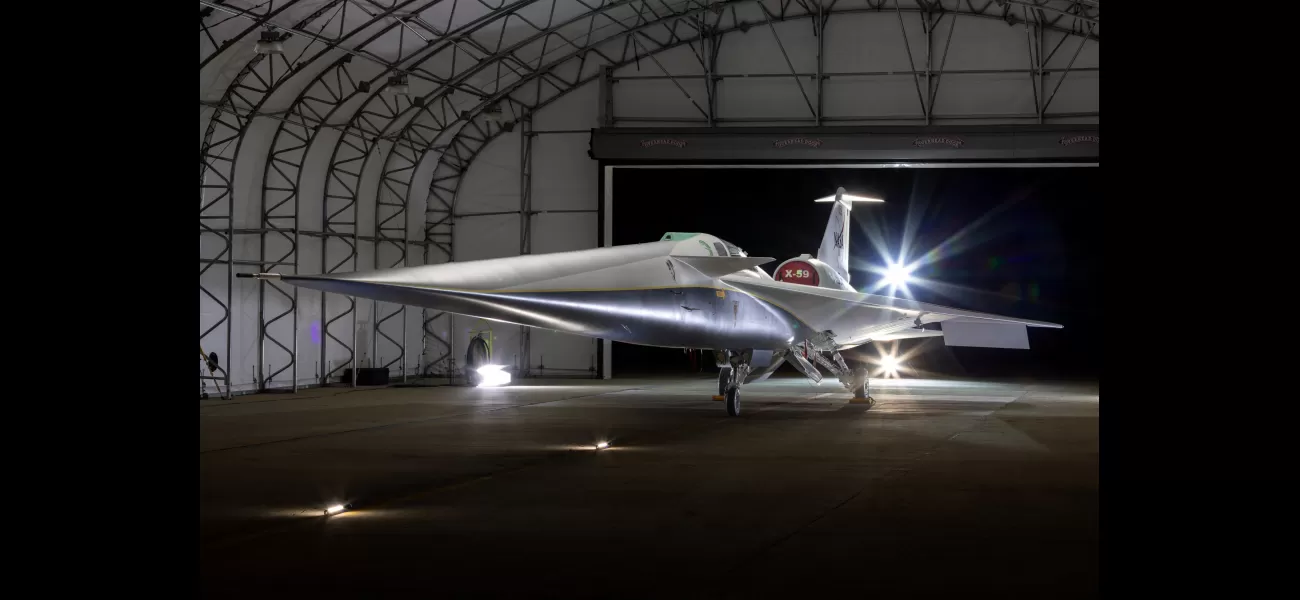NASA reveals new silent supersonic aircraft capable of traveling between NYC and London in just 3.5 hours.
NASA has revealed their new X-59 supersonic plane, built to fly silently without causing disruptive sonic booms.
January 15th 2024.

In a quiet hangar in Palmdale, California, the experimental X-59 aircraft sits, its sleek design and impressive capabilities a result of a partnership between Lockheed Martin's Skunk Works and Nasa. This innovative supersonic jet, measuring 100 feet in length and 30 feet in width, has been the focus of Nasa's Quesst mission, aiming to showcase the possibility of supersonic flight without creating loud sonic booms. And on a sunny Friday afternoon, the freshly painted X-59 was rolled out from Skunk Works' facility, a momentous occasion that was met with great enthusiasm.
Deputy Administrator Pam Melroy, representing Nasa, expressed her pride and gratitude for the hard work and ingenuity of the entire X-59 team. And John Clark, vice president and general manager of Skunk Works, echoed the sentiment, highlighting the incredible progress that has been made in just a few short years. The X-59, with its impressive speed of 925 miles per hour (1.4 times the speed of sound), is set to revolutionize travel and bring people closer together in a fraction of the time it currently takes.
But the X-59 is not just a symbol of progress and ingenuity; it also serves a greater purpose. As part of the Quesst mission, the X-59 will collect data to convince regulators to ease restrictions on commercial supersonic flights, which have been banned for over five decades due to the loud sonic booms they produce. With the X-59's ability to create a quieter sonic thump, it is hoped that it will pave the way for a new era of supersonic travel.
Bob Pearce, an associate administrator for aeronautics research at Nasa, emphasized the potential impact of the X-59, stating that it could open up new markets for US companies and benefit travelers around the world. And the X-59 has already been given the nickname of "son of Concorde," a nod to the famous supersonic jet that was retired in 2003 after a fatal crash. But unlike the Concorde, which flew at a maximum speed of 1,350 mph, the X-59 is expected to be able to travel at almost twice that speed.
But the X-59 is not the only supersonic jet in the works. In 2021, Boom Supersonic announced that United Airlines had plans to acquire 15 Overture passenger jets by 2029, which could also fly from London to New York in just 3 1/2 hours. With the X-59 and other supersonic jets on the horizon, it seems that the future of air travel is set to be faster, more efficient, and more exciting than ever before.
Deputy Administrator Pam Melroy, representing Nasa, expressed her pride and gratitude for the hard work and ingenuity of the entire X-59 team. And John Clark, vice president and general manager of Skunk Works, echoed the sentiment, highlighting the incredible progress that has been made in just a few short years. The X-59, with its impressive speed of 925 miles per hour (1.4 times the speed of sound), is set to revolutionize travel and bring people closer together in a fraction of the time it currently takes.
But the X-59 is not just a symbol of progress and ingenuity; it also serves a greater purpose. As part of the Quesst mission, the X-59 will collect data to convince regulators to ease restrictions on commercial supersonic flights, which have been banned for over five decades due to the loud sonic booms they produce. With the X-59's ability to create a quieter sonic thump, it is hoped that it will pave the way for a new era of supersonic travel.
Bob Pearce, an associate administrator for aeronautics research at Nasa, emphasized the potential impact of the X-59, stating that it could open up new markets for US companies and benefit travelers around the world. And the X-59 has already been given the nickname of "son of Concorde," a nod to the famous supersonic jet that was retired in 2003 after a fatal crash. But unlike the Concorde, which flew at a maximum speed of 1,350 mph, the X-59 is expected to be able to travel at almost twice that speed.
But the X-59 is not the only supersonic jet in the works. In 2021, Boom Supersonic announced that United Airlines had plans to acquire 15 Overture passenger jets by 2029, which could also fly from London to New York in just 3 1/2 hours. With the X-59 and other supersonic jets on the horizon, it seems that the future of air travel is set to be faster, more efficient, and more exciting than ever before.
[This article has been trending online recently and has been generated with AI. Your feed is customized.]
[Generative AI is experimental.]
0
0
Submit Comment





